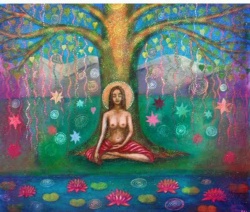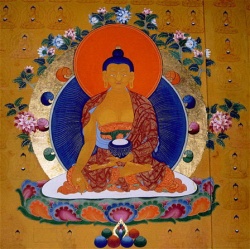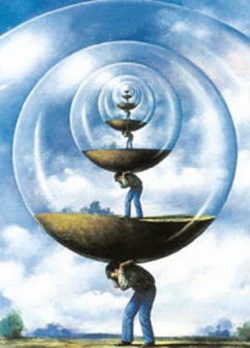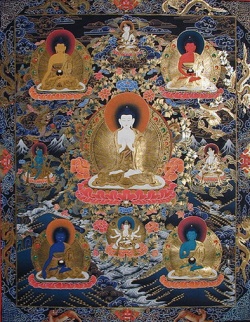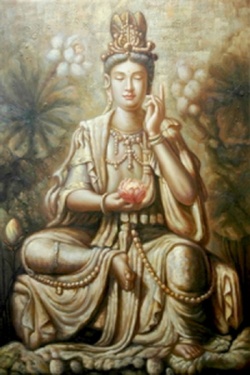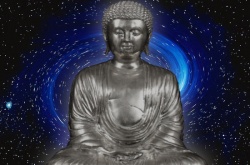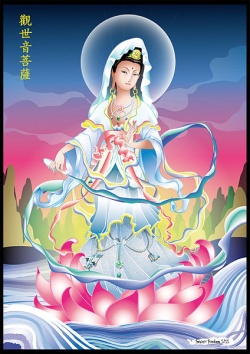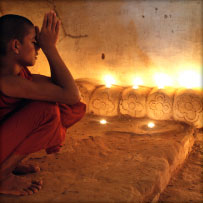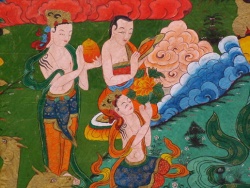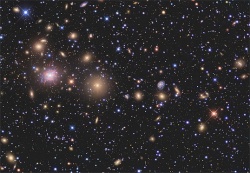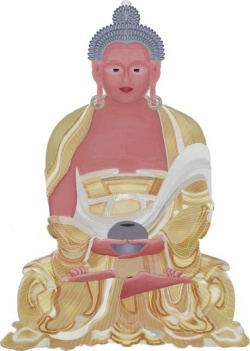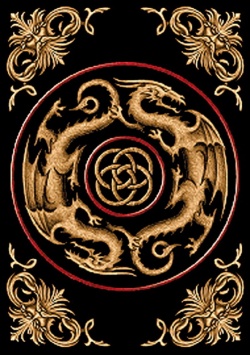Mandala Offering.
Mandala offering is a powerful method for accumulating extensive merit in a short time. The Tibetan word for mandala is kyil.kor: kyil is essence, kor is taking—taking the essence. The term means taking the essence on the base of offering a mandala, and what you get from this is merit—the cause. Therefore the essence you take is the generation of the whole path, from guru devotion up to enlightenment, as well as the result, the unification of the dharmakaya and rupakaya. The cause is merit, the path; and the result is enlightenment. In other words, from this practice inconceivable temporal and ultimate happiness results. One is making unbelievable business with the merit field!
It is mentioned that the better the quality of the offerings that one can imagine, the more details and clarity, the more merit one accumulates. The offerings are explained in the commentaries on the mandala, but it is very good to recite the verse from Lama Choepa when you offer the mandala alone, because you then have the leisure to visualize clearly. Doing it this way you dedicate the merit from each offering for the sentient beings as it is performed. It is very effective for the mind.
There are different types of mandala offerings. The mandala offering practice was taught by Guru Shakyamuni Buddha, and is referred to in the Guhyasamaja Root Tantra, I think in the verses on offerings. That is the reference for mandala offering. It is not just a Tibetan tradition. There is the thirty-seven heap mandala offering according to Drogoen Choegyael Phagpa, the great Tibetan Sakya yogi. Then there are the twenty-five and the twenty-three heap mandalas. According to Lama Tsongkhapa's tradition the twenty-three heap mandala is offered. The twenty-five heap mandala is derived from the one of thirty-seven heaps by leaving out the eight offering goddesses and the specific enjoyments of each continent. These are the jewel mountain, the wish-granting tree, the cow which gives milk unceasingly, and the uncultivated crops. These are visualized, but not mentioned in the recitation because each is the particular enjoyment of one of the four continents and the visualization of the continents includes these enjoyments. No heaps are placed for the eight offering goddesses nor the four enjoyments. One is supposed to visualize them but they are not mentioned separately. If the fence around the base and Mount Meru are not included it becomes the twenty-three heap mandala of Lama Tsongkhapa's tradition.
It is said that once a year, or every month, the mandala plate should be purified. There is a pill called the pachung, which I think the tantric college monks have as they need them for consecrations and other purposes such as fire-pujas. The dung from cows which eat one special grass is used to make these pills. I think there are some other ingredients, not only that! One dissolves the pill into saffron-water and dips one's index finger into that and spreads it around the mandala base. The main purpose is to purify the base with a scented smell in order to accumulate merit.
When performing the offering do not hold the base in an empty hand, but put some grains, or whatever, in your hand first. Then do the action of purifying all of your obscurations and negative karma created by your body, speech and mind; and you can also think of all sentient beings. Put some grains on the base and wipe them off by circling the base three times in a clockwise direction with the outside of your wrist. It is said that there is a nerve in the outside of the wrist which has the function of clairvoyance and the idea is that because of this the purification is a cause for clairvoyance and a clear mind. Then put some grain on the base again and wipe it off three times in a counter-clockwise direction. Think that all the blessings—"blessing" means quality—of the entire merit field's holy body, holy speech and holy mind enters yourself and all the sentient beings.
Then put some grain on the base. I think the reason is similar to what I mentioned elsewhere about Milarepa offering an empty pot. In the teachings it says that due to the dependent arising from offering something empty one gets born in places where there is no buddha.
When you offer the mandala just as an offering you begin with the eastern side towards the merit field; when you are requesting for realizations—before the requesting prayer to the lineage lamas—you have east facing yourself and start with that heap. For requesting, in front of yourself; for offering, in front of the merit field. Geshe Sengye said that when you request the guru to have a long life you start from the side facing the guru.
OM VAJRA BHUMI AH HUM—bhumi means base; OM AH HUM is a blessing.
WANG CHEN SERGYI SAZHI—the golden ground.
OM VAJRA REKHE AH HUM
CHI CHAG RIKOR YUG GYI KOR WA—the iron fence.
U SU RI GYAELPO RI RAB—Mount Meru.
It is good to visualize Mount Meru as you are offering it. It is silver on the eastern side, very white and radiant like the rising sun; the western side is ruby-red and very radiant. That is why here in our continent we have a white sunrise and red sunset. In the south it is radiantly blue like lapis lazuli; the northern side is a golden-yellow radiance, very bright. This is so for all the four levels. Visualize this and offer it mentally.
The main point in regard to the mandala is that the higher the quality of one's visualization, the more merit. In past in regard to Mount Meru I used to say that if were able to see Mount Meru we should also be able to see the Realm of Thirty-three and all the asura and sura realms; we should be able to go there on tours! There would be crowds of airplanes landing there bringing tours! Anyway, if things did not depend on karma and the way things appear to us did not depending on our individual minds we would be able to see these different realms—if the appearance did not depend on the pure and impure mind, the virtuous and non-virtuous thought. For the same reason some people find precious treasures such as gold under the ground although there are many people living in that same area who do not find anything. Even in the same house some people find precious materials easily but some people do not, even though they are trying to, because somehow they cannot see them. Many people may be trying to find something valuable that you have lost, but somehow one person finds it easily. So even these small things are to do with karma. If there is some treasure under the ground, or in water, some people who try cannot find it, while some people find it easily. It all depends on who has accumulated the merit to find it. That people can find treasures or receive enjoyments and wealth is due to their virtuous thoughts.
So we can apply these commonplace occurrences to the question of whether we should be able to see Mount Meru or not. Some people have much difficulty in obtaining wealth, and some people receive it but somehow do not get time to use it, or cannot use it for long. Even if they receive it it is lost or other people steal it or confiscate it or the object gets broken or something. Somehow the person does not find the opportunity to use it for long. We have these different experiences in life. These are to do with not having created the merit, the cause, and having created non-virtue which brings about the hindrances. Even if one does get a job, suddenly something happens and one loses it. Even if one does get money, does earn thousands of dollars, suddenly it is lost or something happens to prevent its enjoyment or use. There are many occurrences like this. Some people cannot get even one hundred rupees during their life. Similarly, some people never see dollars in their lives. We can apply this to Mount Meru: dollars exist—we see them—but those persons never see them in their lives. They may not believe that there is such a thing as a dollar, or a rocket, or TV! That makes other people who do see and have these things laugh. All these things are to do with karma. It is similar with Mount Meru.
A person who does not have even ten rupees, a beggar, may become extremely rich the next day. For example, let us say a beggar buys a lottery ticket for one rupee. Other more wealthy people do not win, but this beggar does. In one hour he becomes very rich and owns many thousands of rupees. The question is this: so many other people have bought tickets, so why is it this particular person who wins? Of course, somebody has to win. I'm not sure whether in lotteries someone has to win or not! However, this person has not chosen the numbers by clairvoyance. Likewise the thousands of other people do not have clairvoyance. But somehow, by luck, it worked and he chose the numbers which were drawn which made it possible to receive the money. He did not know the numbers which will be drawn. There were thousands of people who also chose some numbers. But the organizers drew those particular numbers and this winning person had chosen the same numbers. Actually, when people say it is by luck, that actually means karma—they do not know what they are talking about! They do not know the meaning of what they are saying. Luck means good karma. But common people who do not understand karma, who do not accept that happiness and suffering depend on a cause, generally talk of luck as having success without having created the cause. Something like that. They are saying something about karma, but it is not clear nor complete. Luck is right, but what they think in their mind is that it happened by chance, without the cause having been created.
Why did the beggar choose the same numbers that were drawn? Why this person? One reply could be, due to time. The beggar chose the numbers that they drew because of it being that precise time. But then, who determined the time for this beggar to choose exactly those numbers which the organizers drew? Who determined this time? Then there is no better explanation than because this person is more lucky. Because there is no understanding karma there is no explanation.
Similarly, one set of parents have some children, but while some have perfect organs another has imperfect organs. The reason could be given that the egg was imperfect. Why did this sentient being's consciousness take a fertilized egg which was imperfect? The reply could be because it was the wrong time? But who created, who determined the time? Why did it have to take conception in that particular fertilized egg at that time?
In Darjeeling each year they have horse races and lotteries. I also went once with my manager when I had TB in Buxa. I went on vacation to Darjeeling for many months. My manager took some monks from Tomo Geshe's monastery. That was the first time I saw a lottery. I think my manager bought some tickets, I think one time. A woman from a very poor family won the lottery. She received a big pile of money in her lap which she wrapped in her saris. But the next day she died. She did not have time to use and enjoy the money. I think she may have been too excited! The thing is, she did not have enough karma to be able use the money. She received it, but after she got it she left!
In past courses I used to discuss the question, Why in this continent do we have a blue sky? Why not a yellow or red sky? Why is it blue? That question is to do with Mount Meru. I am sure those of you who attended those courses remember with pains in your ears! We are in the southern continent, and in the teachings it explains that the reason the sky is blue is because of the color of this side of Mount Meru which is lapis-lazuli. Also the blue sky reflects in water, so we see water as blue. In a similar way when a sun-beam hits the water we see white. There has to be some explanation of why the sky is blue. In the teachings it is explained like this. In the eastern continent the sky is white because that side of Mount Meru is silver; red in the northern continent.
Some people see spirits gathering, and other things, when they go to certain places at night or even in the day-time. Other people who go to those places see nothing. That is the appearance of karma, so it is similar. Some bodhisattvas see numberless buddhas and bodhisattvas, but people of an ordinary level such as myself cannot see even one buddha. What we see is just pictures. At Buxa there were some monks who saw spirits in the day-time and night-time in the monasteries and in other places. When they went into a restaurant they saw spirits sitting with the people! And also when the monks were being offered food spirits would sit there and also put out a bowl, but because the other people could not see them they never got food! These things were seen by those with the eye to see.
All these things are to do with karma. Some people went to a place called Urgyen Khadroling, "the Land of Dakinis", but they saw only some sheep and a shepherd, and thorn-bushes. That is all—just barren land. But that location is where the land of dakinis of Urgyen, a pure realm, is supposed to be. But even though one arrives at the same location, one does pot see it; one sees something else. All these examples are similar. What we see is just pictures of buddhas, and the teachings in the form of writing in scriptures. Whilst at the same time many other beings see Lama Tsongkhapa, now, these days. We do not see Lama Tsongkhapa, we do not see the merit field and the deities, but at the same time there are bodhisattvas, great yogis, and even ordinary beings who have thinner obscurations who see Buddha, Tara, Lama Tsongkhapa, or Manjushri. So we just see the blue sky, that is all, and we know the way Guru Shakyamuni Buddha looks just from pictures and statues, and the teachings that the Buddha taught just from writings. According to our present level of mind that is all we see. It is similar with Mount Meru. All these examples are to do with karma.
SHAR LU PAG PA PO
LHO DZAM BU LING
NU BA LANG CHO
CHANG DRA MI NYEN
These are the names of the four continents. The southern continent is yellow, the eastern white, western red, the northern green. The shapes are given in The Wish-fulfilling Golden Sun—the eastern, a half circle; the southern is like the shape of a rickshaw, which you may remember from Bodhgaya!; the western is round; the northern, square.
LU DANG LU PAG
NGA YAB DANG NGA YAB ZHAN etc.
RINPOCHE RIWO—many precious mountains.
PAG SAMGYE SHING—many wish-granting trees.
DOJOBA—the cow that unceasingly gives milk.
MAMO PA YI LOTOG—unceasing crops.
KORLO RINPOCHE—the precious wheel. The golden wheel is made from water, dzam-bu, the name of our continent. It has one thousand spokes five hundred paktse long. It is high in the sky, and very radiant, like a second sun. It can carry four "multitudes" of people, which is to give an idea of how large it is. It can go through space to the four continents and to the realms of the devas very quickly. You can visualize numberless wheels, not just one, in space on the eastern side and offer them. Then dedicate: "By my offering this precious wheel may all sentient beings achieve control of the dharma activity." That means sentient beings receiving all the teachings, understanding the meanings of the words and having the realizations. It could also mean that through having an understanding of the meanings of the words and having the realizations being able to do dharma activities to benefit other sentient beings. Saying "all sentient beings" also includes yourself. If you are a sentient being!
NORBU RINPOCHE—the wish-granting jewel, on the southern side. It is of lapis lazuli. It is described as having eight sides, and the beams which radiate from it reach hundreds of paktse. Even the night-time appears as day to the sentient beings. It gives coolness when the sentient beings are tormented by heat. It eliminates untimely death and disease. Its main quality is that whatever the sentient beings wish for they can receive immediately. I do not know whether there is such a wish-granting jewel in the treasure store-houses—I have not heard. However, there are many stories that in the past the bodhisattvas went to the oceans to get these wish-granting jewels. They had to be cleaned three times as they were completely covered by mud. After cleaning off the mud they were then cleaned another time, and the last cleaning was done with cotton. Then on special days they were placed on banners on the roof. By praying, whatever enjoyment the person wished for he received due to the power of the jewel. They are regarded as the most precious among materials. That is why they are used as a simile for sentient beings—to give an idea of how precious sentient beings are, because each is so kind. Actually there is no material which can compare with how precious the sentient beings are. Even if entire space were filled with wish-granting jewels, and all the jewels which people consider most precious, it still cannot compare with the value of each sentient being to oneself. Because each one is so kind to oneself. But in order to give some idea, the kadam lamas used the wish-granting jewel as a simile because it is the most precious. Then dedicate: "Due to my offering the precious jewel may all the sentient beings accomplish the dharma exactly as they wish."
TSUNMO RINPOCHE—the princess, in the west. She is beautiful, extremely enchanting, with pleasant scents coming from her body and from her mouth. Any sentient being who touches her experiences bliss in the body and mind. She stops the sorrows and the hunger and thirst of the sentient beings who are in that continent. These are the benefits she gives others. She has abandoned the five mistakes of a woman—I think such as anger, jealousy and attachment. They are described in the Lama Choepa commentary and in the mandala commentaries. I think one is dissatisfaction. She has the eight qualities which are opposite to the five mistakes, such as satisfaction or contentment—I do not remember each one. Think of the qualities, then offer, and dedicate: "Due to my offering this princess may all sentient beings enjoy the happiness without fall." Happiness without fall means the happiness that is uncontaminated by delusion.
LOENPO RINPOCHE—the precious minister, in the north. He does not harm other sentient beings; has abandoned anything that is not dharma; is not upset about doing virtuous activities to benefit others; expertly accomplishes whatever work the king has in mind without needing to be told; is expert in leading the armies. Offer, then dedicate: "Due to my offering this precious minister may all sentient beings be able to fulfill exactly the wishes of the buddhas."
These are in space above each continent.
LANGPO RINPOCHE—the precious elephant, in the south-east. It is white and as huge, like a snow-mountain, and has jeweled decorations on its forehead, as you see in India. It has seven limbs—I think it includes the trunk and so on. It has more power than thousands of elephants and can circumambulate the continents three times in one day. The elephant can be easily led, even with a tiny thread and without needing to hit it, because it is so intelligent. It does not harm others and moves in a very subdued way without disturbing the person riding on it. It can defeat enemies. Offer the elephant to the merit field and then dedicate: "Due to my offering this precious elephant may all the sentient beings ride the great vehicle and go to enlightenment."
TACHOG RINPOCHE—the precious horse, in the south-west. Like the flower kumoeta, it is extremely white, and is decorated in a similar way to the elephant. Its color and size are perfect. If one wishes, it can circumambulate all the continents three times in one day. It has a very healthy body, free of disease. It is very glorious and never tires. "Due to my offering this precious horse may all sentient beings have the power of the four limbs of magical emanation." The power of the four zutruel, a quality of the buddhas.
MAGPON RINPOCHE—the precious general, in the north-west. You can think his qualities are similar to those of the minister.
TERCHEN POI BUMPA—the wish-granting vase in the north-east. As I mentioned above, when you have the time, think of the quality of the offering, then offer numberless of them, then dedicate. Whatever sentient beings wish for the wish-granting vase can grant.
GEG MA—the dancing goddess, in the east. Her body is in the aspect of a dancing movement, in an S-like shape.
All these goddesses can be visualized as explained in the Heruka Lama Choepa, where it describes the beauties of their bodies. However, as one is the deity when doing the Lama Choepa or other maha-anuttara yoga tantra practice, their nature is the transcendental wisdom of non-dual bliss and voidness. Each of these eight offering goddesses has the same nature as the sixteen offering goddesses. Each offering goddess is of a beautiful shape so is an offering to the eye-senses of the merit field; has scents coming from her mouth and body, so is an offering to the nose-sense; sings extremely sweet songs, so is an offering to their ear-sense; has a nature of bliss and voidness so is an offering to the mental-sense. Thus each goddess is an object of all the six senses. So there are numberless of each one in space.
TRENGWAMA—the goddess offering a rosary, in the south.
LUMA—scent offering goddess, singing in space in the west.
GARMA—the dancing goddess, dancing with her limbs, in the north. You can think in terms of Western dancing—it does not have to be Tibetan dancing!
Gegma through to Garma are in the cardinal directions. Metogma through to Drichabma are in the corners, the sub-directions.
METOGMA—flower offering goddess, in the south-east.
DUGPOMA—incense offering goddess, in the south-west.
NANGSAELMA—light offering goddess, in the north-west.
DRICHABMA—scented water offering goddess, in the north-east.
These eight goddesses are higher up Mount Meru than the seven possession of a king (wheel, jewel, etc].
Offering goddesses could have similar merit to offering a wisdom mother having sixty qualities in the mandala when we take the secret initiation and the wisdom initiation. It is a preparation for oneself to sooner or later have the experience of bliss and voidness, and then with a wisdom mother be able to cut off the dual view and achieve the unified state of no-more-learning.
NYIMA—the sun, for which you put a heap in the south.
DAWA—the moon, a heap in the north.
I think in some teachings it is explained that nyima and dawa are placed in the south-east and north-west respectively, but Phabongkha Dechen Nyingpo said they should be placed in the south and north. The sun, you should think, represents the wisdoms of all the paths: the wisdom of the lesser vehicle path, the wisdom of the paramitayana path, the wisdom of tantra. The wisdom of tantra means the subtle mind directly realizing shunyata—the simultaneously-born bliss. So that is all wisdoms. There are numberless suns. The moon represents the methods of the lesser vehicle path, the paramitayana path and of the tantra path. The moons are also numberless. Visualizing the sun and moon, the method and the wisdom of the whole path, creates the cause within one's mind to generate the whole path of method and wisdom and achieve the rupakaya and dharmakaya.
RINPOCHE DUG—the precious umbrella, in the west. It has one thousand golden radiant spokes. It has eight corners, on which are lapis-lazuli. On the top is a sapphire and around the edges are various jewels with hanging garlands of pearl, as Vajrayogini has on her crown and her holy body. This decoration is called tawa dhargyey. From the pearls and jewels nectars flow which liberate sentient beings from suffering. This umbrella protects sentient beings from the heat and other true sufferings, and it also protects them from the true cause of suffering by these purifying nectars. You should think that the essence of the umbrella is all the qualities of the cessations. The right-seeing uninterrupted path is the remedy to the delusions; the right-seeing path of abandonment liberates one from the delusions. That is one cessation. Then, the path of meditation ceases the obscurations of the lesser vehicle path, paramita path and tantra path, which is the second cessation. So, the essence of the umbrella is the qualities of the cessation of both the obscurations.
CHOGLE NAM PAR GYAEL WA GYAELTSEN—the banner which is victorious over all the directions, in the east. On the top of the handle is a jewel. The essence of the banner is the qualities of all the realizations. This is offered for auspicious reasons, maybe so one becomes a holder of the teachings and is able to do dharma activities in the manner of Vajradhara.
USU LHA DANG MI...—this is for all the perfect enjoyments of the devas and human beings. According to Geshe Sengye one should put three heaps in the center representing the realizations of the holy body, holy speech and the holy mind of the merit field. It is a preparation for receiving these three realizations.
After you finish setting up the mandala there are two ways to hold it: in order to eliminate obstacles you face the mandala towards the merit field, but in order to receive realizations you face it towards yourself. My mandala has one more ring than they usually do, so I have to fill it. When I was offering mandalas during His Holiness Song Rinpoche's teachings I was using this mandala, and His Holiness used to watch me! His Holiness was very concerned when I left some space empty in this ring. So His Holiness asked me to fill it up. I think it might be for the same reason as not offering empty water-bowls. The same stories!
Then you can think that on each atom of the mandala there are numberless of you making a mandala offering to the merit field. If that is difficult, then think that beams are emitted from each atom of the mandala, and on the tip of each beam there is a mandala; and from those mandalas also beams are emitted according to the number of atoms in each. So in this way there become more and more mandalas and the entire space is completely filled with mandalas. Then you offer these.
The whole point of why we do such elaborate visualization is so that even if you have not done a hundred thousand mandala offerings, if your visualization is clear and you can visualize that many, then you will accumulate the same merit as by having offered a hundred thousand mandalas! So, within two or three days you can actually finish accumulating as much merit as from having separately offered a hundred thousand mandalas—only the number of times that the mandala has been set up and offered is not as great. Even within one minute you can accumulate that much merit. So the whole thing is dependent on the skill of the practitioner.
Now the whole point is, just talking about the mandala might be helpful, but actually visualizing the continents and so on and offering the mandala in this way is a skillful means of buddhas and the lineage lamas of the lam-rim, those who have completed the lam-rim realizations and reached the state of omniscient mind. It is a skillful means to quickly finish the work of accumulating merit in order to generate the realizations from guru devotion up to enlightenment. The main endorsement of the extensive merit accumulated by the mandala offering practice is the story of King Ashoka—how as a child in a previous life he offered sand into Guru Shakyamuni's begging bowl while visualizing it as gold. There was not the slightest amount of gold, but by visualizing gold he received the merit equal to having actually offered gold. As a result in his next life he was reborn as the dharma king Ashoka and built many monasteries and made many offerings to the monks, and built one million stupas. In Phabongkha Dechen Nyingpo's lam-rim he says the king was able to build one million stupas in just one night and so accumulate inconceivable merit. That life-story establishes the benefits of offering the mandala. If you visualize one mandala, in those few seconds you will receive the merit equal to having offered the entire Mount Meru and the continents and all the other things. And if you visualize a hundred thousand or however many, in that minute you receive merit equivalent to having actually offered that many universes, even though you do not own those things.
So on this small base you can make an incredible profit! The base should not be smaller than your own mug or cup. It is said that it should be one cubit wide, but at least it should not be smaller than your tea-cup. The best ones are made of silver or gold and so on, but you can use even a low quality material like a wooden board or a flat stone—like the ascetic lamas do. They use those purposely, to protect their gelong vows, and because valuable possessions can give rise to attachment. They use those things to which clinging does not arise. The materials you place on the base should be the best you can manage: the best is jewels, the middling is conch-shells and grains, and the basest is sand. You can offer any of these.
By making many mandala offerings Gelongma Palmo was able to see and receive teachings from Chenrezig. Likewise for so many great yogis and pundits, including Lama Tsongkhapa. Lama Tsongkhapa did many hundreds of thousands of mandala offerings and realized the unmistaken view—shunyata—and then achieved enlightenment.
When you are counting thousands of mandala offerings you offer the short mandala. It is Lama Tsongkhapa's tradition to begin each mandala offering by reciting sangye choe dang...—the refuge and bodhicitta prayer. You put some grains on the base and wipe them off three times clockwise to purify and then put some more grains and wipe them off counter-clockwise three times to bring realizations; and then you place heaps for Mount Meru, the four continents, and the sun and moon—seven heaps. In general the short mandala is done with seven heaps, but that does not mean you cannot visualize the umbrella and banner. Even though there are only seven heaps, the visualization should be as extensive as you are capable of and include the features of the long offering. Also you should visualize as many mandalas as possible.
Then recite: sazhi poekyi... Saying ...sangye shingla migte ulwa... is not proper because it means "offering to the merit field..." What you have just visualized is ordinary continents, an ordinary place, and you should not offer an impure place to the merit field. But sangye shingtu migte... means "by visualizing this as a field of buddha I'm offering..." So this is correct. If you are making the offering in conjunction with Lama Tsongkhapa guru yoga, then you can visualize the continents as the Tushita pure realm, with Lama Tsongkhapa and Maitreya buddha giving teachings and many sentient beings already enlightened, some are about to be enlightened, and some are half enlightened! I'm joking! If you are offering to Vajrayogini you can think of Vajrayogini's pure realm. You can relate it to the deity to whom you are offering the mandala; that creates the karma for you to be born in that pure realm.
I think sazhi poekyi..." is the stanza the bodhisattva "Always Crying" used when making mandala offerings to his guru Choepa. And sangye choe dang... is a prayer Lama Atisha composed.
The most important aspects of the mandala offering are how clearly you can visualize a mandala, and how many. If these two points are done well you can finished accumulating inconceivably extensive merit in a very short time. That is why in Lama Tsongkhapa's Great Commentary on the Lam-rim he does not explain the details of how to offer a mandala—wipe off this way three times, and three this way, and then put this and that. There are only a few words on the mandala: "Offer a mandala to the merit field by visualizing very clearly." That is all it says. That is how Lama Tsongkhapa's teachings are—a few words. But the most skillful way of practicing mandala offering is mentioned. It is the same for the other preliminary practices. The most important parts, the most subtle and difficult subjects which even the learned ones could not realize correctly or even have a correct intellectual understanding of, Lama Tsongkhapa made very clear and extensive. The nature of Lama Tsongkhapa's teachings is very deep and they contain all the important points. Each word has so much taste, and much power. It gives one deep understanding of deep meanings. As I mentioned before, if you just say the words and do not do the visualization, you will not feel comfortable because that does not fulfill the meaning of the mandala offering practice.
I mentioned Phabongkha Dechen Nyingpo's advice: "If possible, many done perfectly, if not, fewer, but done perfectly." How much merit one accumulates does not depend simply on how many one does. One could perform all the actions of heaping the grains and saying the recitations, but if one does not do the meditation then even if one finishes one hundred thousand it does not mean that one has gained the merits of having offered the whole universe one hundred thousand times. Receiving that merit does not depend on prayers, it depends on the visualization.
Once I saw somebody inside the temple at Bodhgaya offering the mandala. He was Tibetan, maybe a monk, or maybe a lay person. He was holding a mala and the base, and was placing the grains and counting the sazhi poekyi.... He was looking around at the people but counting very quickly. I am just talking about the external appearance, I cannot judge what he really is. But if that is what was happening mentally then maybe it was not so skillful! Of course, I do it in a similar way, so I cannot criticize. I cannot judge that person's mind, but that was just how it appeared. I am sure he does much more and better mandala offerings than I do! I just mentioned this episode as a joke.
As I mentioned, the important thing is clarity and a large number. If you can imagine a hundred thousand universal mandalas, either by transforming them from the first mandala, or visualized on that mandala, by doing the physical action of offering once you can accumulate merits equal to having actually offered one hundred thousand universes. That is so even though the universe that you are offering is visualized and among the grains there may not be the slightest amount of gold or diamond, not even a small part of the umbrella, the banner or the offering goddesses. If you can imagine more than a hundred thousand mandalas, of course, no question!
